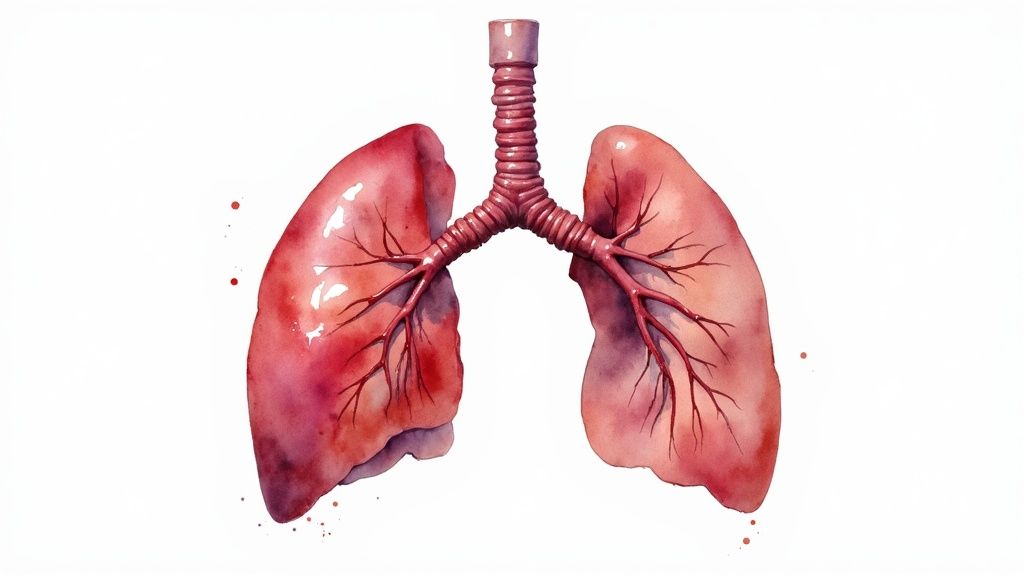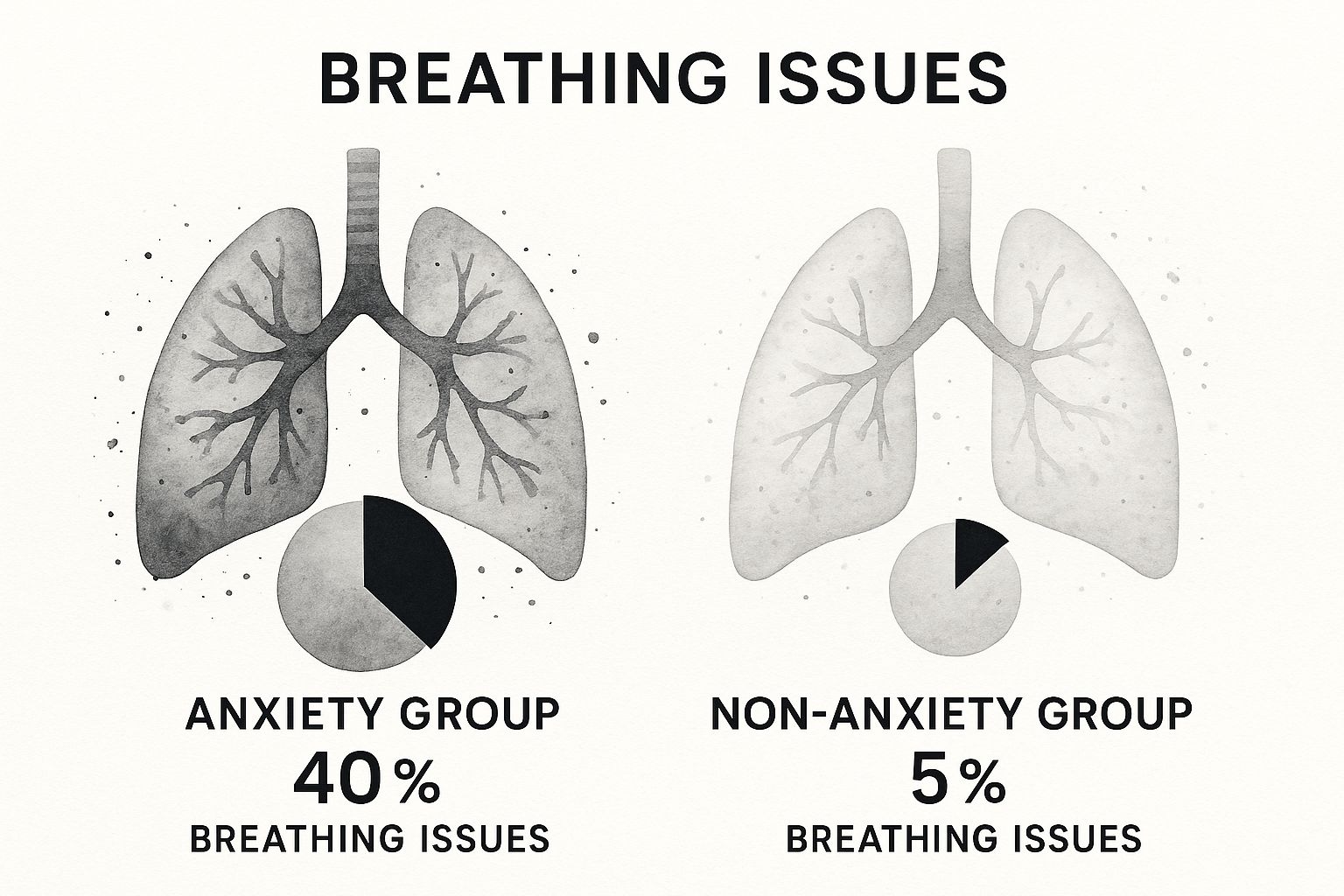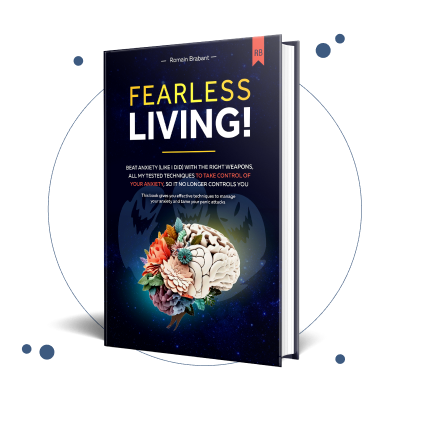
The short answer? Yes, anxiety can absolutely cause breathing issues.
That terrifying feeling like you can’t get enough air, the tightness in your chest, or the sudden urge to gasp for breath—it’s not "all in your head." It's a very real, very common, and most importantly, a very treatable physical effect of anxiety. If you’ve felt this, you are far from alone, and there is a clear path forward to lasting relief and a panic-free life.
Your Path to Panic-Free Living Starts Now

If you’ve ever felt like your lungs just wouldn't cooperate during a moment of intense worry, your experience is completely valid. These sensations are triggered by your body's "fight or flight" response, an ancient survival system designed to keep you safe from danger.
When your brain perceives a threat—real or imagined—it sounds an internal alarm. This alarm floods your system with adrenaline, preparing you for action by making your heart race and your breathing rapid and shallow. It's a powerful mechanism designed to protect you.
The key to healing is understanding that while this system is powerful, you have the power to regulate it. Anxiety is one of the most common human experiences, impacting an estimated 359 million people globally. A huge number of them know exactly what that breathlessness feels like. But here is the hopeful truth: countless people have learned to manage these symptoms and have reclaimed their lives from panic. You can, too.
To give you a quick snapshot, here’s a breakdown of how anxiety can show up in your breathing.
Anxiety's Impact on Breathing at a Glance
This table simplifies the connection between common breathing symptoms and the immediate physiological response happening in your body. Understanding this is the first step toward healing.
| Symptom | What It Feels Like | Why It Happens (The Hopeful Truth) |
|---|---|---|
| Shortness of Breath | Like you can't get a full, satisfying breath. | Your body is over-breathing to prepare you for action. It's a sign of strength, not weakness, and you can learn to calm it. |
| Chest Tightness | A heavy or constricted feeling in your chest. | The muscles around your rib cage are tensing up. This is a temporary state you can reverse with relaxation techniques. |
| Hyperventilation | Rapid, shallow breathing; feeling dizzy or lightheaded. | You're temporarily out of balance. This is a correctable response that you have the power to regulate with simple exercises. |
| Feeling of Smothering | A terrifying sensation that you're suffocating. | This is your brain's interpretation of these signals. By understanding the science, you can teach your brain it's not in danger. |
| Yawning or Sighing | Constantly trying to take a deep yawn to "catch your breath." | This is your body's natural, intuitive attempt to reset its own breathing pattern. It's a sign your body is trying to heal itself. |
Seeing it laid out like this can be a relief. It's not a mystery—it's biology. And what you can understand, you can learn to heal.
Understanding Is the First Step to Healing
The most empowering truth is this: simply understanding why your body reacts this way is the first step toward regaining control and healing. These physical signals aren't a sign that something is terribly wrong with you. They are simply your body's alarm system working a little too well.
You can learn to turn down the volume on this internal alarm. By recognizing the patterns and equipping yourself with the right tools, you can transform these scary moments into manageable ones, and eventually, into distant memories.
This journey is about more than just coping—it's about true recovery. We'll show you how to calm your nervous system, retrain your breathing patterns, and build the kind of resilience that leads to a panic-free life. Exploring proven anxiety recovery steps gives you a structured path to not only manage symptoms but to build a life free from the grip of panic. You have the power to change your relationship with anxiety, and it starts right here.
Understanding the Science Behind Anxious Breathing

To really understand what’s happening when anxiety affects your breathing, let's look at a part of your brain called the amygdala. Think of it as a hypersensitive smoke alarm. Its only job is to detect potential danger.
When you’re living with anxiety, that alarm can become overactive. It starts mistaking everyday stress—like a looming deadline or a crowded room—for a major threat.
This false alarm kicks your body’s ancient survival programming into high gear: the fight-or-flight response. Instantly, your brain tells your adrenal glands to release hormones like adrenaline and cortisol. These are powerful chemicals designed for one purpose: to prepare you for immediate, intense physical action.
That’s why your heart suddenly starts hammering and your breathing becomes quick and shallow. Your body is trying to get oxygen to your muscles so you can either fight or flee—even if the "threat" is just a thought. To go deeper on this, check out our complete fight-or-flight response guide.
The Hyperventilation Effect
This rapid, shallow breathing is called hyperventilation, or over-breathing. It feels like you're desperate for air, but the opposite is happening. You’re actually taking in too much oxygen and exhaling too much carbon dioxide, too quickly.
This temporarily disrupts the delicate balance of gases in your blood. Your body needs a certain amount of carbon dioxide to function optimally. When those levels drop from over-breathing, it causes a cascade of frightening but harmless physical symptoms.
The dizziness, the tingling in your hands and feet, the chest tightness, and that terrifying feeling that you can't get a full breath? Those are not signs of a medical emergency. They are the direct, predictable results of a temporary chemical imbalance caused by hyperventilation—an imbalance you can correct.
Just knowing this is incredibly empowering. The symptoms aren't a mystery; they’re a biological process you can understand and influence.
From Terrifying to Treatable
This knowledge is a game-changer. It shifts the experience from a random, terrifying assault into a predictable and, most importantly, manageable response. The feelings are absolutely real, but they are not dangerous. It's just your body's protective system working overtime.
This understanding is where your healing begins. When you can see these physical signals for what they are—a temporary overreaction of your nervous system—you can start to create space between yourself and the fear, which is the first step to reclaiming your peace.
Here’s a simple breakdown of that chain reaction:
- Trigger: A stressful thought or situation appears.
- Alarm: Your amygdala misinterprets it as a threat.
- Response: The fight-or-flight system releases adrenaline.
- Reaction: Your breathing becomes fast and shallow (hyperventilation).
- Imbalance: Carbon dioxide levels in your blood drop.
- Symptoms: You feel dizzy, breathless, and tingly.
Once you know these steps, the element of surprise is gone. This proves that what you're feeling has a logical explanation. This clarity is the first and most powerful step toward teaching your body that it’s safe, allowing you to calm the alarm and get back in control of your breath—and your life.
How to Recognize Anxiety-Related Breathing Problems

Learning to spot anxiety-related breathing issues in the moment is a huge step toward regaining your calm. The symptoms can feel chaotic, but they follow a familiar pattern. Once you recognize that pattern, the experience becomes less mysterious and frightening, giving you a solid foundation for healing and recovery.
Think of yourself as a detective investigating your own body. Unlike the breathlessness you feel after a workout, anxiety-breathing often appears suddenly and is tied to a stressor, not physical effort. You could be sitting at your desk or in traffic when it hits, seemingly out of nowhere.
This feeling of "air hunger" rarely shows up alone. It almost always brings a crew of other physical and mental symptoms along with it—all stemming from that same fight-or-flight response.
Telltale Signs of Anxious Breathing
When you're trying to determine if your breathing trouble is linked to anxiety, look for clusters of symptoms. It’s almost always the combination of signs that points to anxiety as the root cause.
Here’s a quick snapshot of what to look for:
- A Sudden Onset: The feeling of breathlessness hits you fast, often reaching its peak within 10 to 30 minutes before subsiding.
- Shallow, Rapid Breaths: It feels like you're panting or only taking tiny sips of air from your upper chest instead of deep, full breaths from your belly.
- A Racing Heart: Your heart pounds or flutters in your chest, a classic signal of an adrenaline surge.
- Spiraling Thoughts: Your mind races with "what if" scenarios, a feeling of impending doom, or a desperate fear that something is terribly wrong.
This connection is incredibly strong. Clinical studies consistently find a significant link between respiratory symptoms and anxiety. One study showed that 42.4% of patients with acute respiratory issues also experience anxiety, often creating a cycle where a tight chest fuels more anxiety, which then makes it harder to breathe. Recognizing this cycle is the key to breaking it.
Imagine you're in a crowded supermarket when a wave of dizziness washes over you. Your heart starts racing, and you suddenly feel like you can't get a full breath. These feelings can be intense, but understanding the signs of a panic attack helps you recognize this cluster of symptoms for what it is: a temporary—and harmless—anxiety response that you have the tools to navigate.
Always Put Safety First
While learning these patterns is incredibly empowering, it’s critical to remember one thing: always consult a doctor first. A medical professional needs to rule out any underlying physical conditions like asthma, heart problems, or other respiratory issues.
Once you have that medical all-clear, you can face these episodes with so much more confidence. You’ll be armed with the knowledge to see the signs for what they are—your body's overactive but ultimately harmless alarm system. That clarity is the key to breaking free from the fear and starting on the path to a calmer, panic-free life.
Your Toolkit for Regaining Control Over Your Breath
Feeling your breath slip out of your control is a frightening experience, but this is the moment you start to take your power back.
The physical sensations of anxious breathing are just that—sensations. They are not dangerous, and you can absolutely learn to manage them and ultimately overcome them with practice and the right skills. This isn't about being told to "just relax"; this is about building a practical toolkit of proven techniques you can use to find immediate relief and long-term healing.
The infographic below shows just how common breathing issues are for people dealing with anxiety. It’s not just you.

This data is a powerful reminder that you're not alone in this experience; it's a well-documented symptom. More importantly, it shows that with the right approach, this common issue can be managed effectively, leading to a life where you feel in control.
These methods work by sending direct, calming signals to your nervous system. You're essentially telling your body’s internal alarm system that the threat has passed. You are safe, and it's time to return to a state of calm.
Breathing Techniques for Lasting Relief
When anxiety flares up, your breath can feel like the first thing to go. But your breath is also the key to regaining control. Below is a guide to a few powerful techniques that can help you calm your nervous system, one breath at a time, and pave the way for a panic-free life.
| Technique | How It Works for Healing | Best For |
|---|---|---|
| Diaphragmatic (Belly) Breathing | It encourages deep, full oxygen exchange, which slows your heart rate and activates your body's natural relaxation response, building long-term resilience. | Daily practice to retrain your nervous system for calm and to soothe mild to moderate anxiety. |
| 4-7-8 Breathing | This rhythmic technique acts like a natural tranquilizer, interrupting anxious thought spirals by giving your mind a peaceful focus. | Quickly resetting your nervous system when you feel overwhelmed or are struggling to fall asleep. |
| 5-4-3-2-1 Grounding | This method uses your five senses to pull your attention out of anxious thoughts and into the safety of the present moment, anchoring you in reality. | Disrupting a panic cycle when your mind is racing and you need an immediate anchor to the present. |
Each technique offers a different way to interrupt the anxiety cycle and build a new, calmer response. The best one is whichever works for you, so it's worth getting familiar with all of them as you build your personal toolkit for healing.
Diaphragmatic or Belly Breathing
When anxiety strikes, our breathing often becomes shallow and rapid. Diaphragmatic breathing, or belly breathing, is the powerful antidote. It promotes a full oxygen exchange, which slows a racing heartbeat and signals profound safety to your nervous system.
- Get Comfortable: Sit or lie down in a relaxed position. Place one hand on your chest and the other on your belly.
- Breathe In Slowly: Inhale slowly through your nose for a count of four. As you breathe in, let your belly expand. The hand on your stomach should rise while the one on your chest stays relatively still.
- Breathe Out Slowly: Exhale slowly through your mouth for about six seconds. Feel the hand on your belly fall as you gently release the air.
- Repeat: Continue this rhythm for 5-10 minutes. The goal is to make your exhale longer than your inhale, which activates your body's relaxation response and builds a foundation of calm.
The 4-7-8 Breathing Technique
Developed by Dr. Andrew Weil, the 4-7-8 technique is a powerhouse for restoring calm. Think of it as a natural tranquilizer for your nervous system. It’s especially helpful when you feel overwhelmed and need to hit the reset button, fast.
- Inhale for 4: Breathe in quietly through your nose for a count of four.
- Hold for 7: Hold your breath gently for a count of seven.
- Exhale for 8: Exhale completely through your mouth, making a whoosh sound, for a count of eight.
- Repeat: Go through the cycle up to four times.
This technique gives your mind a peaceful rhythm to focus on, pulling your attention away from spiraling anxious thoughts while physiologically calming your body. It's a simple, portable tool you can use to find immediate relief and remind your body what calm feels like.
Grounding With the 5-4-3-2-1 Method
Sometimes, when your mind is racing, trying to focus on breathing can feel impossible. This is where grounding comes in. The 5-4-3-2-1 method gently pulls you out of your anxious thoughts and anchors you firmly in the safety of the present moment by engaging your senses.
It's simple. Just pause and gently notice:
- 5 things you can see: Look around and name five objects. Notice their color, their shape, their texture.
- 4 things you can feel: Bring your attention to the sensation of your feet on the floor, the fabric of your clothes, or the temperature of the air.
- 3 things you can hear: Listen for three distinct sounds. It could be the hum of a fan, traffic outside, or your own breathing.
- 2 things you can smell: Try to identify two scents in your environment, like coffee brewing or fresh air.
- 1 thing you can taste: Notice the taste in your mouth, or take a deliberate sip of water and focus on the sensation.
This exercise is incredibly effective at short-circuiting a panic cycle. For a deeper dive, our guide on breathing exercises for anxiety offers even more great techniques to support your journey.
Beyond these in-the-moment strategies, exploring natural ways to reduce anxiety can help build a foundation of calm, making these episodes less frequent and less intense as you heal.
Building a Lifestyle That Calms Anxiety
While breathing exercises provide powerful relief in the moment, the path to lasting freedom from panic involves building a life where anxiety has less power over you. This is where we shift from reacting to anxiety to proactively healing. It’s about creating an internal environment so calm and resilient that anxiety struggles to take root.
This journey starts with small, consistent steps. By making sustainable adjustments to your lifestyle, you can fundamentally change your relationship with anxiety, reduce the frequency of breathing symptoms, and build a deep sense of inner peace. The message here is one of genuine hope: you can heal and live a life unburdened by fear.
Fuel Your Body to Calm Your Mind
The connection between what you eat and how you feel is incredibly direct. Some foods and drinks can put your nervous system on high alert, making you more susceptible to anxiety's physical symptoms, including shortness of breath.
For example, caffeine is a stimulant that mimics the effects of adrenaline. For someone prone to anxiety, a strong cup of coffee can amplify anxious feelings. Similarly, diets high in refined sugars and processed foods can lead to energy crashes that leave you feeling jittery and unstable.
On the other hand, a balanced diet full of whole foods—fruits, vegetables, and healthy fats—can stabilize your mood and energy. Foods rich in magnesium (like leafy greens and nuts) and omega-3 fatty acids (like salmon) have been shown to support brain health and reduce anxiety. To learn more, check out our in-depth guide covering the impact of lifestyle and diet changes for anxiety management.
Move Your Body to Process Stress
Physical activity is one of the most effective tools for healing from anxiety. When you feel anxious, your body is flooded with stress hormones like cortisol and adrenaline. Exercise provides a healthy, productive outlet for that pent-up energy.
Regular physical activity helps your body metabolize stress hormones, effectively flushing them from your system. It also boosts the production of endorphins—your brain's natural mood elevators. You don't need to run a marathon to feel the benefits.
- A brisk 20-minute walk can be enough to lower stress levels and reset your mind.
- Yoga or stretching helps release the muscle tension that often accompanies anxiety.
- Any activity you enjoy will be easier to stick with long-term, contributing to lasting change.
By making movement a regular habit, you are actively teaching your body how to recover from stress. This builds resilience, making your system less likely to overreact to future triggers and paving the way for a more peaceful state of being.
Prioritize Restorative Sleep
Sleep and anxiety are closely linked. Anxiety can make it hard to sleep, and a lack of sleep makes you more vulnerable to anxiety. A tired brain is an anxious brain.
Improving your sleep hygiene is a crucial step toward building a panic-free life. This means creating a consistent and relaxing bedtime routine that signals to your body it’s time to wind down. Try to go to bed and wake up around the same time each day. Ensure your bedroom is dark, quiet, and cool.
By taking these small, deliberate steps—nourishing your body, moving regularly, and prioritizing sleep—you are not just managing symptoms. You are fundamentally rebuilding your foundation, creating a life where calm is your default state and breathing comes easy.
Anxious Breathing: Your Questions Answered
As you start using these tools, it's normal for questions to arise. Think of this as a quick chat to address common concerns and reinforce your confidence on this healing journey.
The most important thing to remember is this message of profound hope: you absolutely can learn to manage these symptoms. You can calm your nervous system and build a life that isn't dictated by panic. Healing isn't just possible; it's within your reach.
Can Anxiety Really Cause a Constant Feeling of Shortness of Breath?
Yes, it absolutely can. When anxiety is chronic, it can create a persistent, nagging feeling that you just can't get enough air, often called "air hunger."
This happens because long-term stress can subtly change your breathing patterns over time. You might have unconsciously adopted a shallow, upper-chest breathing style. This way of breathing is less efficient and can leave you with that lingering sense of breathlessness. This is exactly why practicing diaphragmatic breathing daily is so transformative. It literally retrains your body to return to its natural, deep, and calming rhythm, bringing lasting relief.
How Do I Know if My Breathing Issues Are From Anxiety or Something Else?
This is the most important question, so let's be crystal clear: see a doctor first. Always. It is absolutely essential to rule out any underlying medical conditions like asthma, allergies, or heart issues. Your health and safety are the top priority.
Once a doctor has given you the all-clear, you can look for the tell-tale patterns of anxiety. Anxiety-related breathlessness is usually:
- Situational: It appears or worsens when you're feeling stressed or overwhelmed.
- Accompanied by other symptoms: It rarely shows up alone. It often comes with a racing heart, spiraling thoughts, or tense muscles.
- Responsive to calming techniques: You’ll likely notice it eases when you use grounding exercises or other relaxation techniques.
That said, if you ever experience severe chest pain, fainting, or see a blueish tint to your lips or skin, seek immediate medical attention.
Getting that medical all-clear is incredibly empowering. It allows you to face these sensations not with the terror of a physical catastrophe, but with the confidence of knowing this is just a manageable anxiety response—one you have the tools to heal.
Can Breathing Exercises Make My Anxiety Worse at First?
It might sound counterintuitive, but yes, this can happen sometimes. If it does, please know that it’s okay and very common. It doesn't mean you're failing.
When you first focus all your attention on your breath, you can become hyper-aware of the very sensations you’re trying to calm. This can briefly spike your anxiety as you worry, "Am I doing this right?"
If this happens, the key is to be gentle with yourself. Don't aim for a ten-minute session. Just try for one minute of slow, gentle breathing. Forget about complex counting. Simply focus on making your exhale a little longer than your inhale. That tiny action sends a powerful calming signal to your nervous system. You can also pair it with a physical grounding technique—like pressing your feet firmly into the floor—to shift your focus to a solid, neutral sensation.
The path to overcoming anxiety is a journey of building skills, self-awareness, and profound self-compassion. With The Anxiety Checklist, you get a structured, supportive guide to help you every step of the way toward a panic-free life. Reclaim your breath, restore your calm, and start living the life you deserve.
Learn more and get your toolkit at https://anxietychecklist.com.

